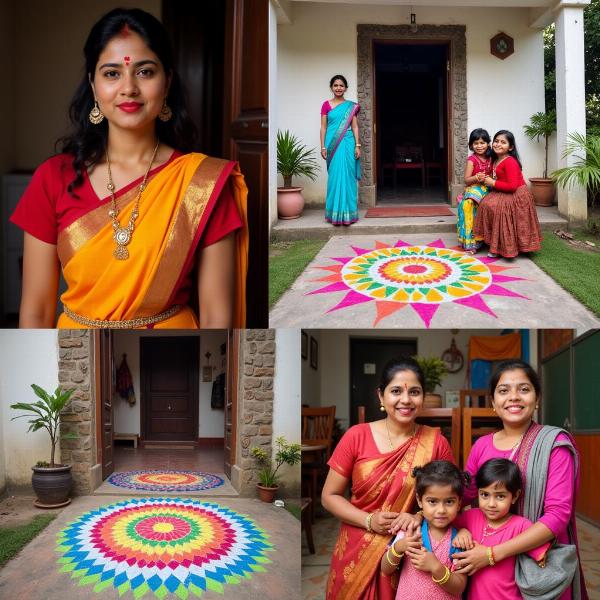Understanding the meaning of symbols in Hindi is key to unlocking the rich tapestry of Indian culture. From ancient scriptures to everyday life, symbols (प्रतीक – pratik) play a vital role in conveying complex ideas, beliefs, and emotions. This article delves into the significance of various symbols in Hindi, exploring their historical context, religious connotations, and cultural impact. Whether you’re interested in religious iconography, traditional art forms, or simply curious about the symbolism embedded within Indian culture, this guide will offer valuable insights.
Decoding Religious Symbols in Hindi
Religious symbolism is deeply ingrained in Indian culture, with Hinduism, Buddhism, Jainism, and Sikhism each boasting a rich lexicon of visual metaphors. Understanding these symbols offers a window into the spiritual beliefs and practices of these faiths. For example, the Om (ॐ) symbol, representing the primordial sound of creation, is revered across multiple religions. Similarly, the Swastika (卐), an ancient symbol of auspiciousness and good fortune, is commonly seen in Hindu temples and homes. Even the lotus flower (कमल – kamal), a symbol of purity and spiritual awakening, holds profound significance in various Indian traditions.
Symbolism in Everyday Indian Life
Beyond religious contexts, symbols are woven into the fabric of everyday Indian life. From the vibrant colours used in festivals and ceremonies to the intricate patterns adorning traditional clothing and jewelry, each element carries symbolic weight. The colour red (लाल – laal), for example, often symbolizes marriage, fertility, and prosperity. Similarly, the bindi (बिंदी), a decorative mark worn on the forehead, signifies marital status and spiritual awakening. Even the simple act of greeting with folded hands (नमस्ते – namaste) is a symbolic gesture of respect and humility.
 Everyday Symbols in India
Everyday Symbols in India
Exploring the Deeper Meaning of Symbols
The meaning of a symbol often extends beyond its literal representation. For instance, the peacock (मोर – mor), India’s national bird, is not merely a beautiful creature; it symbolizes beauty, grace, and immortality. Similarly, the cow (गाय – gaay), revered as a sacred animal in Hinduism, represents motherhood, nourishment, and selfless giving. Understanding these deeper layers of meaning enriches our appreciation of Indian culture and its profound connection to symbolism.
How can I learn more about specific symbols?
You can explore dedicated resources like dictionaries of symbols, academic texts on Indian culture, and online platforms focusing on Hindu mythology.
What is the significance of hand gestures (mudras) in Indian classical dance?
Mudras are symbolic hand gestures used in Indian classical dance forms like Bharatanatyam and Kathakali. They convey specific meanings and emotions, adding another layer of storytelling to the performance.
The Power of Symbolic Language
Symbols serve as a powerful language, transcending linguistic barriers and communicating universal truths. They encapsulate complex ideas in a visually accessible form, making them easily understood across generations and cultures. By studying the meaning of symbols in Hindi, we gain a deeper understanding of the values, beliefs, and traditions that shape Indian identity.
What are some common misconceptions about Indian symbols?
Some symbols, like the Swastika, have been misinterpreted or appropriated in other cultures, leading to distortions of their original meaning. It’s crucial to understand the symbols within their original cultural context.
How are symbols evolving in modern India?
While traditional symbols retain their significance, new symbols are emerging in modern India, reflecting the changing social and political landscape. For example, the tricolour flag, a symbol of national unity, has become a potent symbol of Indian identity.
Conclusion: Embracing the Rich Symbolism of India
Understanding the meaning of symbol in Hindi unlocks a deeper appreciation for the rich cultural heritage of India. From religious icons to everyday objects, symbols permeate every aspect of Indian life, conveying profound messages and shaping cultural narratives. By embracing the power of symbolic language, we can gain a more nuanced understanding of India’s diverse traditions and its enduring legacy.
FAQ:
- What does the Om symbol represent? The Om symbol represents the primordial sound of creation and is considered sacred in Hinduism, Buddhism, and Jainism.
- Why is the cow considered sacred in Hinduism? The cow is revered as a symbol of motherhood, nourishment, and selfless giving in Hinduism.
- What is the significance of the lotus flower in Indian culture? The lotus flower symbolizes purity, spiritual awakening, and the ability to rise above adversity.
- What is the meaning of the bindi? The bindi, a decorative mark worn on the forehead, signifies marital status and spiritual awakening.
- Why is red considered an auspicious colour in India? Red often symbolizes marriage, fertility, and prosperity in Indian culture.
- How can I learn more about Indian symbolism? You can explore resources like dictionaries of symbols, academic texts on Indian culture, and online platforms focusing on Hindu mythology.
- What is the significance of hand gestures in Indian classical dance? Hand gestures, known as mudras, convey specific meanings and emotions in Indian classical dance, enhancing the storytelling aspect of the performance.
Related Articles:
teal color meaning in hindi
rudraksh name meaning in hindi
miter meaning in hindi
sceptred meaning in hindi
Meaning-Hindi.in is your premier destination for professional Hindi translation services. We offer a comprehensive range of solutions, from business and legal document translation to website localization and technical manual translation. Our expert linguists ensure accuracy and cultural sensitivity in every project. Contact us today for your Hindi translation needs at [email protected] or call us at +91 11-4502-7584. Meaning-Hindi.in is committed to bridging language barriers and fostering effective communication across cultures.